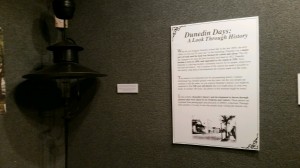I hope everyone had a wonderful Fourth of July weekend! I was visiting my family outside of Pittsburgh, PA, so I did not get a chance to post last week. But, I’m back now! One project that I’m trying to begin is publishing a book. This is one of my major goals while I’m working on finishing my Master’s degree, and working at DHM offers me a great opportunity to try to do that. So, I’m in the process of proposing a book that would tell the history of Dunedin through artifacts in the museum’s collection. I’d like to take this opportunity to present an example of what I want to do!
My goal is to take a deep look at 50 artifacts in the museum’s collection and really showcase the stories they hold. Through doing that, the history of Dunedin will be revealed in a less “historical” manner. This means that it will have a personal, detailed, and even funny flair! Everyone likes a good story and I hope to record the stories that our artifacts tell.
One of the first artifacts that came to my mind when I began thinking about this project was a large kerosene lamp. This lamp is the only one of its kind left in Dunedin, and it used to hang in the oak trees that lined the center of Main Street to provide light for travelers. My story does not directly tell that of the lamp, but it does reflect what the lamp bore witness to.

This postcard depicts Main Street as what it was prior to 1913. The oak trees separate two sides of the road.
In the early 1900s, only a few hundred people called Dunedin home. Main Street contained a few stores, a post office, and a pathway down to the water and the very prestigious Victoria Drive. The street itself was nothing more than sand strewn with straw, a row of oak trees down the center separating the two sides, and deep ruts carved into the soft surface from wagon and early car wheels. Sidewalks made of boards lined the street allowing people to have a sturdier surface to walk upon. Sybil Christie, a member of one of Dunedin’s pioneer families, remembered how loud the boards were. She recalled in an interview from 1970 how people made a “clumping” sound on the boards that could be heard during prayer meetings at church. She also recalled how she and her childhood friends would lift up loose boards if they found any to look for change that had fallen and rolled through the cracks.
By 1913, city officials were ready to expand the tiny town of Dunedin. Pinellas County was formed and with that came the idea to build a road connecting St. Petersburg to Tarpon Springs. Dunedin officials hopped on board with that plan. The plan required that Main Street be bricked over and the oak trees be removed from it. On the day that the county workers came to begin cutting, local women of the Village Improvement Society sat on their tools and tied themselves to the trees right under the kerosene lanterns in protest. The workers could not carry out their assignment, and the local sheriff arrived to break up the trouble. He convinced the women to return home for the night and to meet with the county workers in the morning to strike an arrangement. The women went home and when they got back in the morning, all of the trees had been cut down; the county workers had gotten up early and beaten them to the site.
The various accounts of this story in the books and interviews found in the museum’s library and archives then outlines how furious the women were, and understandably so! They were certainly deceived and made fools of, though today, it is a story marked with hilarity, rather than anger and resentment. All of the interviewees who were able to remember this story offered a bit of a laugh to go along with it.
So many of DHM’s artifacts have great stories, or at the very least bore witness to great stories, and I think it is very important to let people in on what these artifacts have to tell. I hope to be able to share more stories like this in book form in the future. As always, let us know if you have any questions or comments, and of course, stop in and visit between 10am and 4pm Tuesdays through Saturdays!



I applaud you for this undertaking. I am impressed and I know your book will be a success. Are you planning to interview old timers?
Let me know if I can in any way help you.
Melba Rilott
Thank you so much, Melba – your support means so much!! I’m not sure if I’ll be conducting any interviews, but I’ll let you know when I decide. And, if you stop in any time soon, I’d love to show you what I’m working on in person 🙂
I am back in town now for the summer so will stop in soon
Looking forward to seeing you!